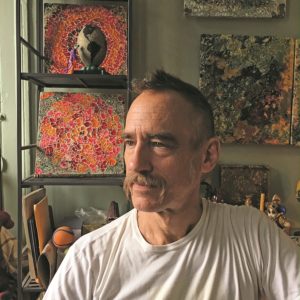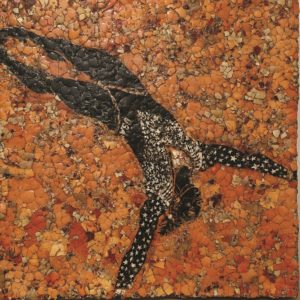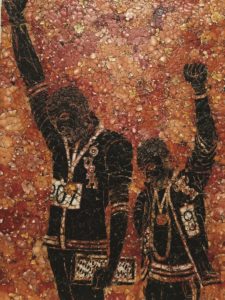“Eggman” is how Paul Wirhun signs all his emails. It’s also the name that’s displayed on his screen during a recent Zoom call from Jersey City, N.J., where he maintains a studio.
As a creative medium, eggs have been part of Wirhun’s life since he was eight years old. “I grew up in a Ukrainian family,” he says. “My grandparents had emigrated, and I was taught this traditional artwork among Ukrainians that we called pysanky.” The term refers to Easter eggs decorated with a wax-resist method.

Fifty-two years later, Wirhun is still employing the craft of pysanky, but in a fine art manner going beyond its Ukrainian craft roots. His new show, “Olympiada,” opening Friday, Aug. 6 at the William Scott Gallery in Provincetown, commemorates Olympic figures from past and present portrayed with fragmented colored eggshells.
In direct reference to Attic black-figure pottery from the fifth century B.C., Wirhun adopts an orange, black, and white palette to depict the sinewy figures of Usain Bolt, Greg Louganis, and Bruce Jenner, among others. He uses a jigsaw puzzle of eggshell shards epoxied to a wooden support. The results are small marvels of compulsiveness that exude a kinetic energy appropriate to their subject.
Wirhun grew up in Connecticut. In his sophomore year of high school, he entered Saint Basil Ukrainian Catholic Seminary in Stamford, and then received a scholarship to Catholic University in Washington, D.C., where he graduated with a B.A. and M.A. in philosophy. “All of my academic education was geared toward becoming a priest in the Ukrainian Catholic church,” he says. He had “a strong classical education.”
What Wirhun calls his “gestalt shift” — when he realized he could pursue pysanky in a professional, artistic capacity — happened around 1990. “It was like the world opened up to me,” he says. “The line that changed me was, ‘At least I’ve mastered something.’ I’ve taken the same technique, the same process, and then developed it on my own, taking it way beyond the traditional norm.”

With his friends’ encouragement, he moved to Provincetown, where he stayed until 1998. “Living there, I was making money from art as well as restaurant work — typical of P’town life,” he says. “I had a summer job with unemployment in the winter, working more full-time as an artist in the off season.” Though he doesn’t live here anymore, he still visits often.
Wirhun started collaging with broken eggshells, rather than using whole eggs, in part, he says, because he needed “a bigger canvas to work with.
“The first thing I do is sit the whole eggshell in vinegar, which is my setting agent for the dye, but it’s also the thing that will literally eat at an eggshell,” explains Wirhun. “That chemical process is how the dye gets into the shell.” The burnt orange background color is dyed first. Wirhun then draws on the egg with beeswax, which acts as a resist, before applying the black dye — a technique called batiking.
The final step is several coats of lacquer buffed with steel wool to a dull finish to make the background recede and the figure pop. The pieces have a graphic quality of flat color fractured into tiny fragments.
Rendering contemporary athletes in an ancient form, Wirhun links past and present. “I’m fascinated by world views and wisdoms that are locked into the way the ancients perceived their reality,” says Wirhun. “It’s locked into their imagery, and so how does that speak to us today?”
Wirhun thinks about what makes an image iconic. “I’ve chosen athletes who have done something that caused them to rise up to the top of our imagination — in terms of who they are, or in terms of the majesty of their ability, things achieved through their own training.”

Among those Wirhun has immortalized in eggshell are Jesse Owens, who won gold at the 1936 Berlin Olympics, and Babe Didrikson, who won a gold medal in the 1932 Los Angeles Olympics and is one of the most decorated athletes ever across an array of sports.
Wirhun also chose “athletes who excelled to the top of their form, or had moments that changed history.” He names Tommie Smith’s and John Carlos’s famous Black Power salute at the 1968 summer games in Mexico City. And then there’s Simone Biles, whose partial withdrawal from the Tokyo Olympics was both tragic and inspiring.
Wirhun makes all the figures black, including Michael Phelps, consistent with how male figures were rendered in Attic black-figure pottery (female figures were white). “On one level this is about achievement,” he says. “It’s also achievement in the face of the reality. It’s a recognition and recontextualizing into this social moment. I’m signaling achievement in the face of adversity and asking, what if we looked at a world where everybody was the same color?”
Some may question Wirhun’s choice of medium. The reasoning, Wirhun says, is that “eggs are an event. They’re not just an object, they’re an event. And the shell is the memory of the event.”
Shell Game
The event: “Olympiada,” a show of works by Paul Wirhun
The time: Friday, Aug. 6 through Aug. 18
The place: William Scott Gallery, 439 Commercial St., Provincetown
The cost: Free
